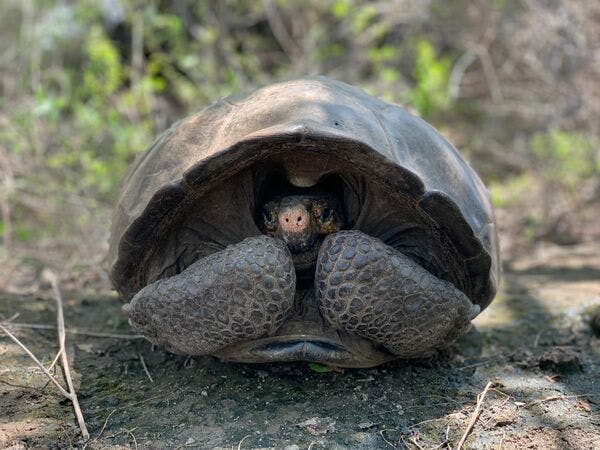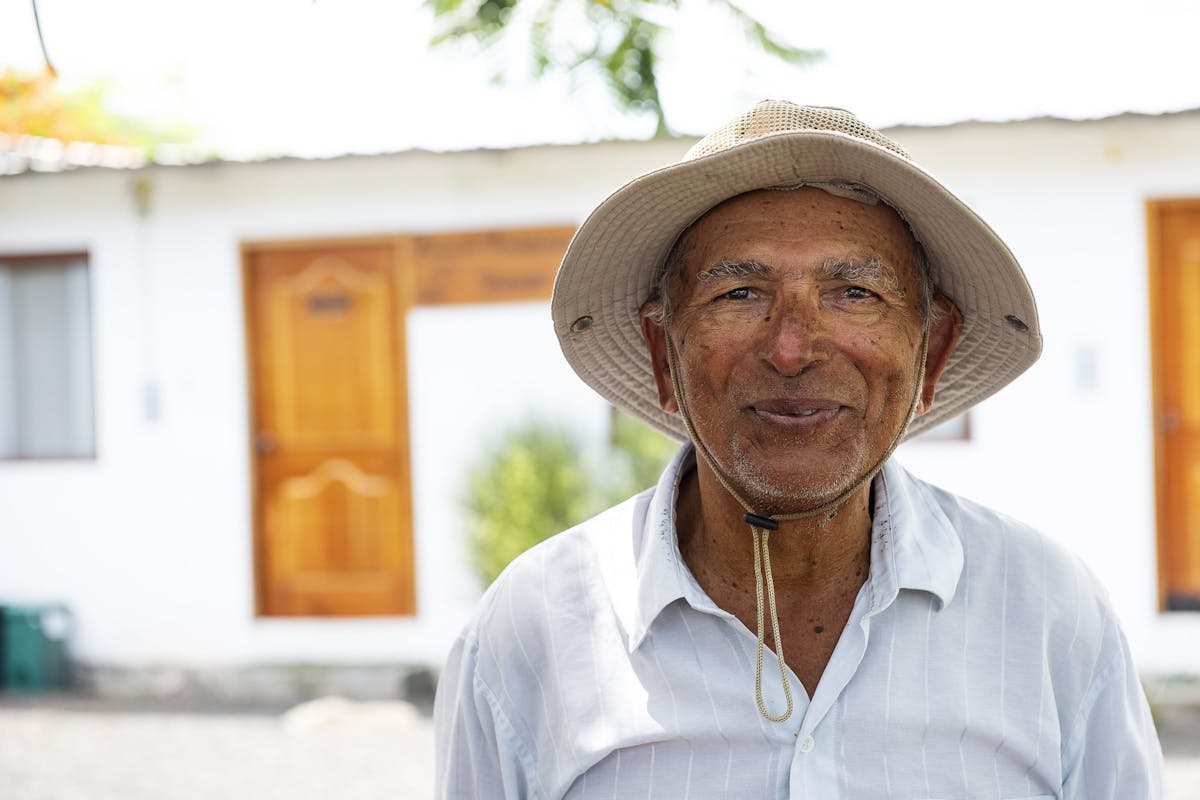 BACK TO NEWS
BACK TO NEWSA bold plan to rewild the Galápagos will start with Floreana Island
Re:wild, Island Conservation and their partners will work with local communities to bring back tortoises, mockingbirds and flycatchers to the island
By Devin Murphy on August 13, 2021 
Latin America’s Pacific archipelagos and islands, stretching from Mexico to Chile, are microcosms of incredible wildlife. They are home to more than 2,300 species found nowhere else on Earth, and their waters support large populations of fish, seabirds, and marine mammals.
The islands’ isolation has meant the delicate balance they enjoyed for millennia is especially sensitive to changes, like overfishing or the arrival of invasive species. If their incredible biodiversity, from ridge-to-reef, were restored, the effects would be felt across the region and the world.
“Island ecosystems have an incredible capacity to recover swiftly and dramatically in response to restoration efforts,” says Penny Langhammer, Re:wild’s executive vice president. “Restoring islands creates cascading benefits for the surrounding marine environment and vice-versa.”
Their ability to bounce back has made the islands the perfect candidates for an ambitious and first-of-its-kind plan to rewild Latin America’s Pacific archipelagos and islands over the next 10 years. If it’s successful, the plan could be a model for rewilding ecosystems around the world while supporting local communities, which will be critically important during the next pivotal decade for combating the climate and extinction crises.
“There is an urgent need for a region-wide initiative,” says Langhammer. “Although much of the terrestrial area is already legally protected, and there are many conservation and rewilding successes on individual islands, we have an incredible opportunity to replicate those successes at scale to prevent further loss of biodiversity and lessen the impacts of climate change.”
The cascading benefits of the ridge-to-reef restoration efforts will extend directly to local communities as well, protecting their food and water supplies, promoting economic growth, preserving their cultures, and--at a regional scale--driving economic recovery through nature-based tourism and fisheries. The effort will be a large undertaking, bringing together international and local conservation organizations, local communities, as well as governments.
“We’re working with Island Conservation and other partners to catalyze conservation investment,” explains Langhammer. “The unprecedented region-wide collaboration aims to restore at least 25 islands, protect at least 30% of each country’s waters, halt and reverse the decline of at least 260 globally threatened species, double the areas under effective conservation management, and provide inspiration and a replicable model for others to adopt.”
Helping Floreana flourish
The decade-long plan to rewild Latin America’s Pacific archipelagos will roll out in phases with the first focusing on Ecuador’s famous Galápagos archipelago, specifically Floreana Island.
Floreana Island, one of the Galápagos’ five islands inhabited by humans, is also home to many unique species, like endemic land snails, Galápagos Petrels, Blue-footed Boobies and Hammerhead Sharks. But it has been experiencing local extinctions almost since Charles Darwin visited the Galápagos. Many of those local extinctions were caused by invasive predators, like cats and rats, that were accidentally introduced to the island by humans.
“Floreana is one of the islands in the archipelago where there has never been endemic rodents,” explains Paula A. Castaño, a wildlife veterinarian and island restoration specialist with Island Conservation. “You have or had on other islands in the archipelago endemic rodents. The [native] species were able to cope with them and learn how to survive...so they were not as affected when the invasive rodents came.”
If invasive rats and cats were eradicated from the island, 13 locally extinct species could be reintroduced to Floreana. The Floreana Giant Tortoise and Floreana Mockingbird are two of the species that could once again roam Floreana and help rewild the island ecosystems in the next few years.
Tortoise engineers
Floreana Giant Tortoises were once a favorite maritime snack for sailors crossing the Pacific. During pit-stops to the Galápagos, they would collect tortoises and bring them on board to be eaten later. However, the slow-breeding tortoises, which can live to be more than 100 years old, couldn’t keep up with sailors’ appetites and they were extirpated from Floreana. Ironically, sailors’ taste for tortoises may have saved them from total extinction.
“Luckily for us, there is a story of potentially one of those boats sinking off the coast of Isabela,” says Castaño. “That’s how they think these hybrids of Floreana Giant Tortoises and other ones arrived on [Isabela’s] Wolf Volcano.”
Conservationists suspect that a ship with a stash of Floreana Giant Tortoises sank near Isabela Island, but at least some of the tortoises didn’t go down with the ship. Instead, they washed ashore.
In 2015, conservationists scoured Isabela Island for tortoises with saddlebacks, one of the distinguishing characteristics of the Floreana Tortoise. Several had been spotted years earlier and had piqued the interest of conservationists and rangers with Galápagos National Park. After an extensive search, they found 127 tortoises at the base of Wolf Volcano, and some of them had very promising genes. They were hybrids of Floreana Tortoises and another tortoise species from the Galápagos.
After genetic testing, Galápagos Conservancy and Galápagos National Park moved 32 tortoises that were the most genetically similar to Floreana Giant Tortoise to a breeding center on Santa Cruz Island. They have been raising baby tortoises, and one day they could return the animals to Floreana. And when the tortoises do return, they could reshape the entire island.
“The giant tortoises are known for being ecosystem engineers,” explains Castaño. “There will be a lot of different changes in how the plant communities will look on the island. They will be able to disperse more seeds for the cactus trees and other species that are native.”
The tortoises will uproot trees and shrubs to build nests, and in the process they will return much of the island to a savanna-like ecosystem. Without the tortoises, areas of the island have turned to forest, and restoring native plants will be critical to the success of other species that conservationists hope one day will also return to the island.
Island-hopping birds
One of the species that will be able to return to Floreana with the help of an ecosystem engineer and seed disperser like the Floreana Giant Tortoise is the Floreana Mockingbird. The small bird was the first mockingbird Charles Darwin described in 1835, and disappeared from the island shortly after.
Unlike the Floreana Giant Tortoise, there are two small populations of Floreana Mockingbirds that have survived on nearby Champion and Gardner Islets The small islets don’t have invasive predators, but the populations on both are still incredibly small. Conservationists would like to reestablish a population on Floreana, which is large enough to support more than a few dozen birds.
Island Conservation and Galápagos National Park are hoping to bring juvenile Floreana Mockingbirds to the western part of Floreana where the birds can establish their own territories. If the young birds are successful, the population on Floreana will grow as they mature and begin to breed.
Some mockingbirds will be reintroduced near Puerto Velasco Ibarra, the only town on Floreana. Since the birds disappeared from Floreana about 180 years ago, no one on the island has a living memory of them. But the hope is that one day, people will be able to see them up close and hear their songs. (Unlike other mockingbirds, the Floreana Mockingbird doesn’t imitate the songs of other birds.)
Gone but not forgotten
The Vermilion Flycatcher is one bird species that has disappeared, but hasn’t faded from the residents of Floreana’s memories. The bright red bird went extinct on the island about a decade ago, but no one is sure why.
“They're very iconic because that's one of the only species that has actually different colors,” says Castaño. “[I]t’s red and black...so it's very pretty.”
The Philornis Fly, a parasitic fly, may be partly to blame for the Vermilion Flycatcher’s disappearance, as well as other species’, like the Medium Tree finch. However, experts can’t rule out other changes to the islands that were brought about by humans.
“Humans have been changing all the habitats,” explains Castaño. “When people were starting to settle, you have areas that have been changed for agriculture. You also have invasive plants, like the blackberry, that is affecting some areas.”
Invasive blackberry plants have spread throughout Floreana like weeds. The dense plants make it hard for birds to forage for insects on the ground through their thick cover. It has also largely outcompeted native plants that some species like the Vermilion Flycatcher prefer.
The Vermilion Flycatcher still survives on nearby Isabela Island, so there’s hope that after invasive predators have been eradicated from Floreana, conservationists will be able to successfully bring it back.
From flycatchers to raptors
After species like the Floreana Giant Tortoise and Floreana Mockingbird have been reintroduced and have recovered, conservationists can begin to bring back predators, like Galapagos Hawks. Unlike other species, invasive predators didn’t cause Galapagos Hawks to disappear from the island. The hawks came into conflict with humans because they preyed on domestic chickens.
Island Conservation has been working closely with the local community to build chicken coops that will protect chickens from hawks.
“For example, when we introduce the hawks, they are not going to be able to eat the chickens...because they are under mesh and so they are covered,” says Castaño.
Rewilding the future
The reintroductions on Floreana won’t only include tortoises, mockingbirds and hawks.
“We are working with several partners...to develop feasibility assessments for the introduction of all the other species. There’s around five species of finches that we can reintroduce to the island. We have a barn owl, we have the Galapagos Racer...we also have a Lava Gull. That is the only very rare gull, the most rare in the world. There are about 300 individuals left in the Galápagos Islands.”
Several of the species could return to Floreana on their own if invasive species are removed from the island.
“All of these aspects are being analyzed at the moment and we’re identifying what the needs are of each species,” says Castaño. “Based on that, we’ll decide with all our partners, including Galápagos National Park, what will be the best way to go for all of this.”
About the author
Devin Murphy
Devin Murphy is Re:wilds’s senior communications specialist and helps Re:wild and its partners tell stories about the work they do to protect wildlife and wildlands around the planet. Her favorite stories about conservation include fascinating and little-known species and the dedicated humans protecting them.


